Why American ice hockey rinks are smaller than European rinks
Facts about the ice hockey rink
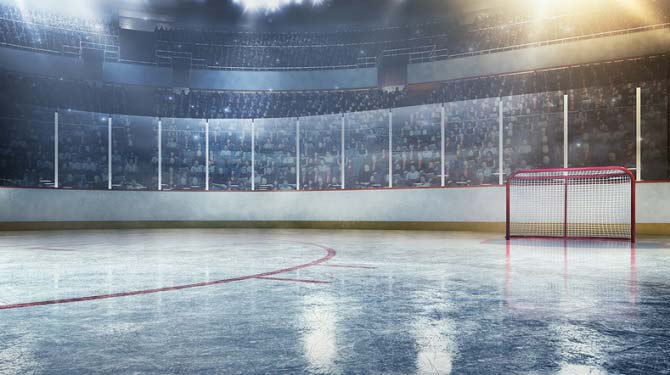
Four yards - that is the difference between US and EU rink sizes. But what does a smaller rink mean for the American game? What does a ice hockey rink look like? We have the answers for you.
Size matters
Did you know that rink sizes differ between Europe and America? There are clear differences. We have compared the dimensions of ice hockey rinks between the DEL (German national league) and the NHL.
Length:
DEL 61 yards
NHL 60.96 yards
Width:
DEL 30 yards
NHL 25.91 yards
While the length hardly varies, NHL rinks are almost 5 yards shorter.
Are you surprised about the quirky dimensions of the NHL? There is a very simple explanation: in America, the unit of measurement is foot. One foot is 30.48 centimeters. The NHL hockey field is therefore 200x85 feet wide.
Because of the smaller rink in the NHL, the rink is shorter and narrower. NFL players share less room which leads to a more action-packed game. In short: players have less time to play the puck, need more speed and more physicality to beat the opponent.
The slightly larger European rink, on the other hand, gives the players more room. This favours thought-out tactics and set plays over physicality.
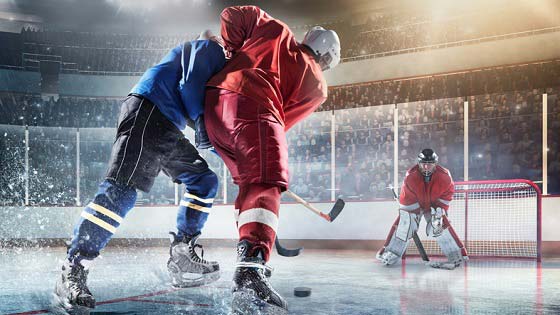
By the way: The NHL rink could also be used by the teams of the German League. Although the German League usually plays on a 61x30 yard rink according to Olympic standards, the German League only requires the rink be 56 to 61 yards long and 26 to 30 yards wide. This also applies to the American ice hockey rink.
Lines over lines - how a ice hockey rink is put together
Do you find the lines on the hockey rink confusing? We can remedy that. We'll explain what the lines mean, which sections of the field they mark and what else belongs on an ice hockey rink.
Boards
Essential for an ice hockey rink are the boards. They are a crucial part of the game of ice hockey and players use them to their advantage, for example, by hitting the opponent into the boards. The boards also function to protect the spectators.
The upper half of the boards are made of thick glass to protect the spectators. The bottom half consists of a 1.20 yard high wooden or plastic board, which is often used for advertisements.The bottom yellow stripe is called the kickplate.
By the way: The boards must be able to withstand pucks at speeds of 100 mph.
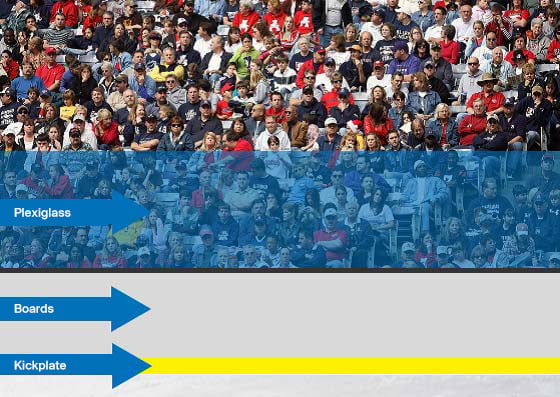
Lines
The many lines on the ice hockey rink can be confusing at first glance. But it's actually quite simple:
- The blue lines and the red, thin goal line mark the different zones of the rink.
- The thick centre line marks the two halves, called the red line.
- There are eight more points on the field of play, 4 of which are surrounded by red circles.
- In the middle of the rink on the boards is the referee circle.
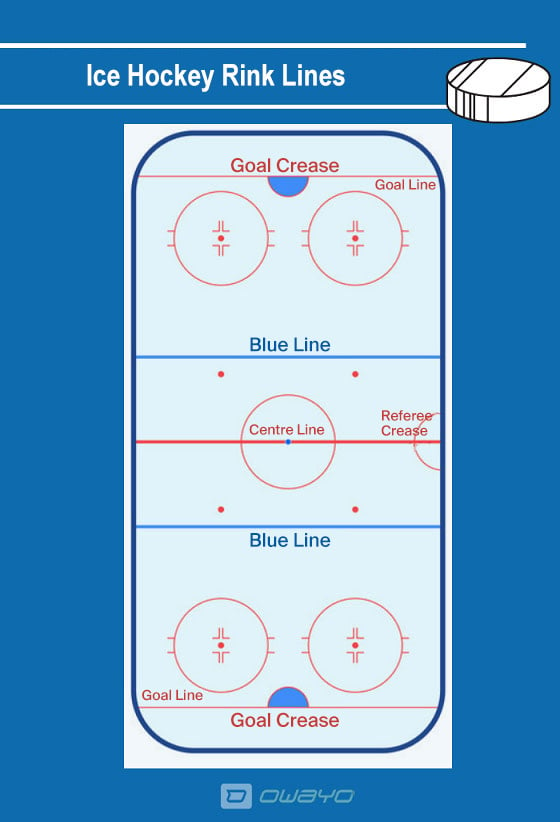
Zones
The most intense phases in the game take place in the attacking zones. Whoever makes it there has a good chance of scoring a goal. The attacking zone is always on the side of the opponent's goal. On your own goal side, however, you will find the defending zone.
In the middle between the two blue lines is the neutral zone. Here teams fight for puck possession.
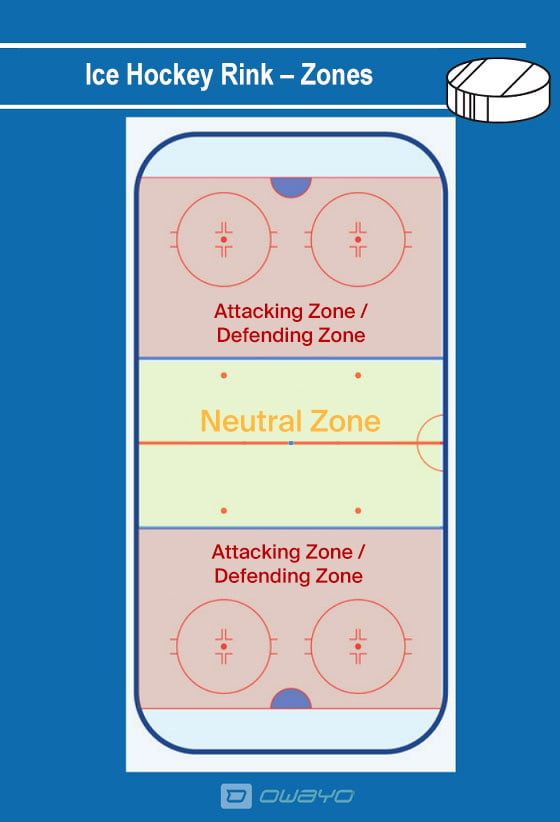
Did you know? The IIHF (International Ice Hockey Federation) adjusted the size of the neutral zone to the size in the NHL in 2014/2015. Thus the neutral zone shrank by three yards and the blue line is now 22.86 yards (previously 21.33) from the end of the field.
Faceoffs
Have you already noticed the points on the rink? Those are the faceoff circles. In addition to the faceoff in the middle of the field of play, there are a total of eight other spots on the rink. The puck is dropped here after the play is called dead.
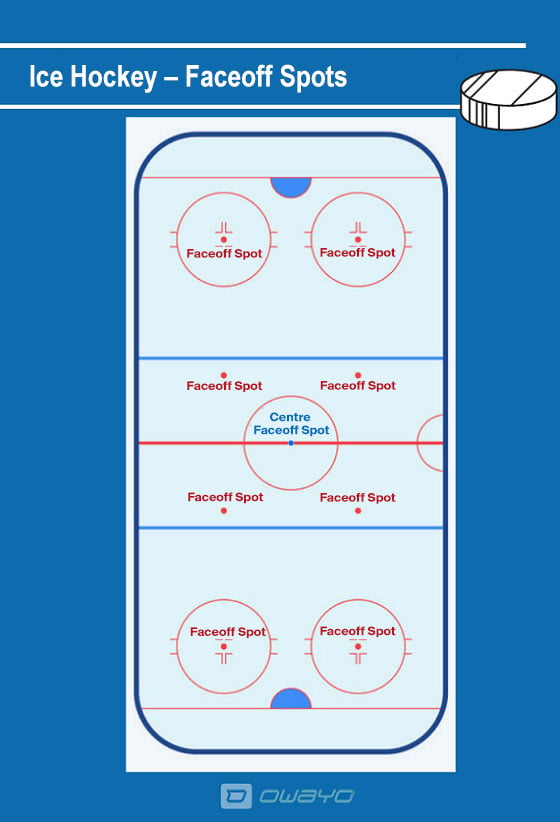
Referee circle
The red referee circle has a radius of three yards and is, strictly speaking, more like a semicircle. You can find it at the side of the rink in the middle. In the circle, the referee can discuss penalties and instigate official reviews undisturbed, as players are not allowed to enter the circle.
The crease
Since the 2018/2019 season, there have been some changes in the German League (note that the link is in German). One of the most striking changes is the reduction of the crease size. This means that the goal crease is no longer 142 inches wide, but only 96 inches. The goal crease has a radius of 72 inches, so that it now extends 1 inch further into the rink.
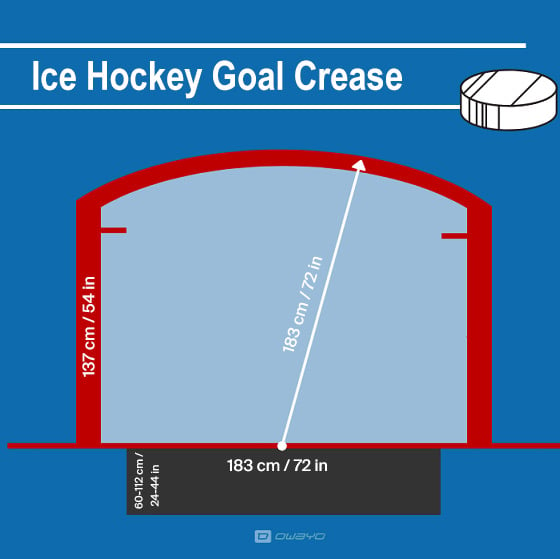
Goal
For those familiar with goal sizes in football, the ice hockey goals are quite small. Indeed, the goals in ice hockey are only 48 inches high and 72 inches wide (dark grey at the top of the graphic).
Did you know? Goals, zones - and an office? Yes, that is also part of the construction of an ice hockey field. But of course Gretzky's office is not a real office: it's the area directly behind the goal. From this position, ice hockey player Wayne Gretzy (born 1961) has provided almost 2,000 goals as the Canadian centre. From 1979 to 1999 he scored for the New York Rangers and the Los Angeles Kings, among others.
From the concrete floor to the ice hockey rink
Now you know what a ice hockey rink looks like, but how do the lines actually get into the ice? After the workers have cleaned the floor and lowered the temperature, it is time to spray the ice. But the ice is not immediately white. It is actually painted. Several times at once, so that the hockey field is completely white afterwards. Then the workers paint the lines on (and advertisements too) or stick them on the ice. Then another layer of ice follows, through which the markings on the playing field are clearly visible.
In this video, you can see how the rink is put together:
Did you know? The ice is about 1 inch thicker after painting. It takes about a week to create the rink and more than 180 litres of paint are used.
Interesting facts about ice hockey
A smaller rink like in America allows for a faster game. But this is not the only difference between the German League and the NHL. Did you know, for example, that in the NHL, fistfights are only punished with a 5 minute penalty?
You can find even more interesting facts about the rules of ice hockey in our article "Ice hockey rules explained simply". Or browse our article "Ice hockey positions: Everything you need to know" and find out why the goalkeeper plays a key role in ice hockey.
We wish you a great ice hockey season!
Title image: © gettyimages/Dmytro Aksonov, Image 1: © gettyimages/Dmytro Aksonov, Image 2: © owayo, Images 3-5: © owayo inkl. Spielfeld-Grafik © gettyimages/mas0380, Image 6: © owayo